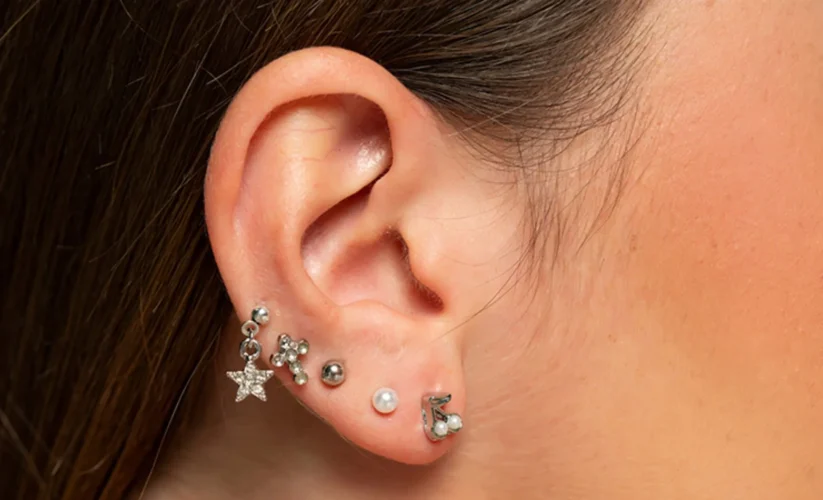
Is a Conch Piercing Right for You?
Are you thinking about a conch piercing? It can look very beautiful in your ear decoration, but this type of piercing is not suitable for all people. The pain level in conch piercings is typically higher than that of lobe piercings because it goes through cartilage tissue, and the healing process may last many months.
Types of Conch Piercings
There are several variations of conch piercings, each offering a unique look and experience.
Inner Conch Piercing: It is placed in the inner part of the conch, nearer to the middle of the ear and ear canal. Normally, people put on a labret stud or flat-back stud for a discreet but fashionable appearance.
Outer Conch Piercing: This piercing is placed on the outer edge of the conch, nearer to the ear’s rim. It usually has a segment ring or clicker hoop, which gives a smooth and classy appearance.
Double Conch Piercing: Just like the name implies, this includes two distinct piercings on the conch. These can be done in either inner or outer areas of conch, even a mix of both. It permits imaginative jewelry pairings and provides a more intense appearance.
Triple Conch Piercing: Three conch piercings are done. This type of piercing provides extra space for personalization and creates an attention-grabbing look. For this kind of piercing, you need to have the right body structure and lifestyle since it takes longer to heal and demands more aftercare.
Vertical Conch Piercing: This type of piercing runs up and down through the conch cartilage’s thicker area. It’s for people who like a less flashy, low-key style; usually, they put on a labret stud.
Anatomy and Placement
Although conch piercings appear attractive on numerous individuals, positioning is determined by anatomy. An experienced piercer will evaluate the shape of your ear and thickness of its cartilage to find the best location for your piercing.
This guarantees that jewelry fits correctly, you feel comfortable while it heals, and decreases any possible complications from occurring. No matter if you like a stud or a hoop, the piercer will think about your requested style to make sure it’s placed in an attractive and useful way.
Pain Level and Healing Time
Conch piercings usually hit harder than lobe piercings. The cartilage is tougher than soft tissue, so you might feel a more intense pain during the process. Do not worry if there is a sound like crunch that is just the person who is piercing going through your cartilage, it’s completely okay.
The good news? If you take care of it well, your piercing can heal all the way in 3 to 9 months. Anticipate an initial rise in size, redness and sensitivity. As the weeks progress into months, these symptoms will lessen but careful cleaning is important during the healing process.
Choosing Your Piercer and Jewelry
The choice of the piercer is very important for a safe and good conch piercing. It’s crucial to find someone who is skilled in cartilage piercings and holds a positive reputation. Look if they are part of groups like the Association of Professional Piercers (APP), check that their tools used are sterilized, as well as high-quality implant-grade titanium jewelry being utilized by them.
For jewelry, the first item you get is probably a labret stud or segment ring. It could have a longer post to allow for swelling in your fresh piercing.
Conch Piercing Aftercare
Aftercare is like a best friend forever for a content conch piercing. Do gentle cleaning two times in one day using saltwater or more mild soap that your piercer suggests. Stay away from strong chemicals and do not play with the piercing. Allow it to heal peacefully. When sleeping, attempt to not press against the fresh piercing.
The main factor is patience in maintaining the aftercare process for some months, so that your piercing can heal smoothly and become a lovely and robust one.
Potential Risks and Complications
Though these piercings are usually safe if taken care of, there are some dangers that you should know about. The most frequent issue is infection. Therefore, it is very important to be watchful with cleaning and hygiene practices.
If you notice more redness or swelling around the piercing area, pus formation or a raised body temperature this could signify an infection outbreak in your earlobe’s conch cavity consult a doctor promptly for treatment advice.
If you think there might be an infection, go to a doctor right away. Other possible complications are allergies to the material of jewelry, keloids, and migration.
Do’s and Don’ts
Clean it two times every day using saline solution, and keep away from touching or turning the jewelry. Listen to your body if you rest on one side during sleep, employ a travel pillow to prevent applying force on the piercing. Lessen the size of your jewelry, as recommended by the person who pierced you.
Avoid using strong soaps, makeup and other similar items around or on your piercing area. Do not go swimming, put your head under water or involve in activities that may catch the jewelry for a few months. With proper care, your conch piercing will heal beautifully.
Cost Considerations
The price for a conch piercing can change depending on where you are, the expertise of the piercer and what kind of jewelry is selected. Normally, pay around $30 to $70 only for getting the piercing hole made, with possible extra charge if any specific type or size of jewelry has been chosen.
Though it might seem like a good idea to pick based on cost alone, keep in mind that selecting a trustworthy person who uses top-quality jewelry will promote your wellbeing and determine how well your piercing does. Keep safety and hygiene as the most important factor.
Conch Piercing with Different Ear Shapes
Anxious that your ear anatomy isn’t appropriate for a conch piercing? No problem! Professional piercers have experience dealing with different types of ears, and they can find the best spot to put your conch.
For smaller ears, positioning closer to the central area or slightly lower on the conch can give a more balanced appearance. If your ears are rounder in shape then you might consider placing it slightly higher for an elongated look.
If you have ears that stick out, a conch piercing can help bring some definition and focus to the middle of your ear. The main solution for any worries about anatomy is to talk with a professional piercer.
They will check your ear form, thickness of cartilage and discuss where it’s best to place the conch piercing so you have one that looks good on you and feels comfortable according to how unique you are.
Can You Change Your Conch Piercing Jewelry?
Be patient, especially with changes of jewelry for your conch piercing. Normally, the full healing time is from 3 to 9 months so try not to change your jewelry too quickly. When you feel that your conch is fully healed and there is no tenderness, redness or discharge present – this might be a good moment for changing up the pieces in it. But, you must go to your piercer for this initial change.
They will confirm that the piercing has completely healed and correctly put in the fresh piece to prevent any irritation or difficulties. For picking out more jewelry later on, opt for top-notch implant-grade titanium or substances appropriate for extended use.
Conch Piercings vs. Other Cartilage Piercings
Conch Piercings are a special type of statement piece that you can put on your central cartilage in the ear. If we compare this to helix piercing, conch may need more time for healing because it involves thicker cartilage. These types of piercing, which connect two points on the helix with one bar, are more complicated and require very unique anatomy to accommodate bar placement.
If you want something subtle but still noticeable, then a conch piercing might be great for you. If your preference is closer to the top part of your ear, then a helix piercing could work well. And finally, if someone wants to make more of a bold statement and they have suitable anatomy for it an industrial piercing can be quite striking indeed! In the end, the most fitting piercing for you is determined by your style preference, ability to handle pain and personal ear structure. Always talk with a piercer about your choices to get a good match.
This type of piercing present a distinct and lovely method to decorate your ear. But always remember this: understanding is the key! If you do careful study, follow post-piercing care steps correctly and have a skilled piercer guide you, then it’s probable that your path towards rocking an awesome conch piercing will be quite smooth.





